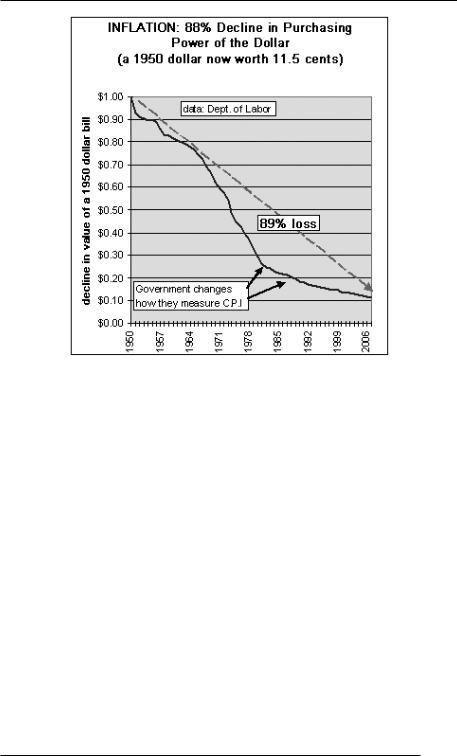
Brown Web of Debt The Shocking Truth about our Money System (3rd ed)
.pdf
Chapter 9 - Lincoln Loses the Battle
additional debt-free Greenbacks, augmenting the money supply and putting the unemployed to work, returning the country to the sort of full employment and productivity seen in Benjamin Franklin’s time. The Greenbacks could also be used to redeem the federal debt. Under the “Ohio Idea,” all government bonds not specifying payment in gold or silver would be repaid in Greenbacks.9 The plan was not adopted, but the Scarecrow had shown he had a brain. The Timid Lion had demonstrated the courage and the collective will to organize and make a difference.
In 1875, a Resumption Act called for redemption by the Treasury of all Greenbacks in “specie.” The Greenbacks had to be withdrawn and replaced with hard currency, producing further contraction of the money supply and deeper depression.
In 1878, the Scarecrow and the Tin Woodman joined forces to form the Greenback-Labor Party. They polled over one million votes and elected 14 Representatives to Congress. They failed to get a new issue of Greenbacks, but they had enough political clout to stop further withdrawal of existing Greenbacks from circulation. The Greenbacks then outstanding ($346,681,016 worth) were made a permanent part of the nation’s currency.
In 1881, James Garfield became President. He boldly took a stand against the bankers, charging:
Whosoever controls the volume of money in any country is absolute master of all industry and commerce . . . And when you realize that the entire system is very easily controlled, one way or another, by a few powerful men at the top, you will not have to be told how periods of inflation and depression originate.
President Garfield was murdered not long after releasing this statement, when he was less than four months into his presidency. Depression deepened, leaving masses of unemployed to face poverty and starvation at a time when there was no social security or unemployment insurance to act as a safety net. Produce was left to rot in the fields, because there was no money to pay workers to harvest it or to buy it with when it got to market. The country was facing poverty amidst plenty, because there was insufficient money in circulation to keep the wheels of trade turning. The country sorely needed the sort of liquidity urged by Lincoln, Carey and the Greenbackers; but the bankers insisted that allowing the government to print its own money would be dangerously inflationary. That was their argument, but critics called it “humbuggery” . . . .
96

Web of Debt
Chapter 10
THE GREAT HUMBUG:
THE GOLD STANDARD AND THE STRAW MAN OF INFLATION
“Hush, my dear,” he said. “Don’t speak so loud, or you will be overheard – and I should be ruined. I’m supposed to be a Great Wizard.”
“And aren’t you?” she asked.
“Not a bit of it, my dear; I’m just a common man.”
“You’re more than that,” said the Scarecrow, in a grieved tone; “you’re a humbug.”
“Exactly so!” declared the little man, rubbing his hands together as if it pleased him. “I am a humbug.”
– The Wonderful Wizard of Oz,
“The Magic Art of the Great Humbug”
Humbug is a word that isn’t used much today, but in the Gilded Age it was a popular term for describing frauds, shams and con artists. Vernon Parrington, a Pulitzer prize-winning historian
writing in the 1920s, used it to describe the arguments of the bankers to silence the farmers who were trying to reform the banker-controlled money system in the 1890s. It was the farmers who particularly felt the pinch of tight money when the bankers withheld their gold. Parrington wrote that the farmers “pitted their homespun experience against the authority of the bankers and the teaching of the schools.” In response to their clear-headed arguments, the bankers defended with a smokescreen of confusing rhetoric:
Denunciation took the place of exposition, and hysteria of argument; and in this revel of demagoguery the so-called educated classes -- lawyers and editors and business men -- were perhaps the most shameless purveyors of humbuggery. Stripped
97

Chapter 10 - The Great Humbug
of all hypocrisy the main issue was this: Should the control of currency issues -- with the delegated power of inflation and deflation -- lie in the hands of private citizens or with the elected representatives of the people? . . . [But] throughout the years when the subject was debated in every newspaper and on every stump the real issue was rarely presented for consideration. The bankers did not dare to present it, for too much was at stake and once it was clearly understood by a suspicious electorate their case was lost.
Hence the strategy of the money group was to obscure the issue, an end they achieved by dwelling on the single point of inflation . . . .1
The Quantity Theory of Money
The gold standard and the inflation argument that was used to justify it were based on the classical “quantity theory of money.” The foundation of classical monetary theory, it held that inflation is caused by “too much money chasing too few goods.” When “demand” (the money available to buy goods) increases faster than “supply” (goods and services), prices are forced up. If the government were allowed to simply issue all the Greenback dollars it needed, the money supply would increase faster than goods and services, and price inflation would result. If paper money were tied to gold, a commodity in limited and fixed supply, the money supply would remain stable and price inflation would be avoided.
A corollary to that theory was the classical maxim that the government should balance its budget at all costs. If it ran short of money, it was supposed to borrow from the bankers rather than print the money it needed, in order to keep from inflating the money supply. The argument was a “straw man” argument – one easily knocked down because it contained a logical fallacy – but the fallacy was not immediately obvious, because the bankers were concealing their hand. The fallacy lay in the assumption that the money the government borrowed from the banks already existed and was merely being recycled. If the bankers themselves were creating the money they lent, the argument collapsed in a heap of straw. The money supply would obviously increase just as much from bank-created money as from govern- ment-created money. In either case, it was money pulled out of an empty hat. Money created by the government had the advantage that it would not plunge the taxpayers into debt; and it provided a permanent money supply, one not dependent on higher and higher levels of borrowing to stay afloat.
98

Web of Debt
The quantity theory of money contained another logical fallacy, which was pointed out later by British economist John Maynard Keynes. Adding money (“demand”) to the economy would drive up prices only if the “supply” side of the equation remained fixed. If new Greenbacks were used to create new goods and services, supply would increase along with demand, and prices would remain stable.2 When a shoe salesman with many unsold shoes on his shelves suddenly got more customers, he did not raise his prices. He sold more shoes. If he ran out of shoes, he ordered more from the factory, which produced more. If he were to raise his prices, his customers would go to the shop down the street, where shoes were still being sold at the lower price. Adding more money to the economy would inflate prices only when the producers ran out of the labor and materials needed to make more goods. Before that, supply and demand would increase together, leaving prices as they were before.
That theoretical revision helps explain such paradoxical data as the “economic mystery” of China. The Chinese have managed to keep the prices of their products low for thousands of years, although their money supply has continually been flooded with the world’s gold and silver, and now with the world’s dollars, as those currencies have poured in to pay for China’s cheap products. The Keynesian explanation is that prices have remained stable because the money has gone into producing more goods, increasing supply along with demand. Keith Bradsher, writing in The New York Times in February 2006, observed:
A longstanding mystery for economic historians lies in how so much silver and gold flowed to China for centuries for the purchase of Chinese goods, yet caused little inflation in China. Many of China’s manufactured goods remained much cheaper than other countries’ manufactured goods until the early 1800’s, despite the rapidly growing supply of silver sloshing around the Chinese economy. One theory is that Chinese output was expanding as fast as the precious metals supply . . . The same phenomenon has appeared today, as dollars inundating China have resulted in practically no increase in prices for most goods and services (although real estate prices have jumped in most cities).3
By 2007, Chinese economists were complaining that consumer prices were rising, but this was primarily due to the rising international costs of fuel and food, and to the fact that the yuan was tightly pegged to a U.S. dollar that was rapidly becoming devalued in international
99

Chapter 10 - The Great Humbug
markets. Price inflation from changes in exchange rates, as we’ll see later, is a different thing from inflation due to an increase in the supply of “money” over “goods and services.”
The Remarkable Island of Guernsey
While U.S. bankers were insisting that the government must borrow rather than print the money it needed, the residents of a small island state off the coast of England were quietly conducting a 200year experiment that would show the bankers’ inflation argument to be a humbug. Guernsey is located among the British Channel Islands, about 75 miles south of Great Britain. In 1994, Dr. Bob Blain, Professor of Sociology at Southern Illinois University, wrote of this remarkable island:
In 1816 its sea walls were crumbling, its roads were muddy and only 4 1/2 feet wide. Guernsey’s debt was 19,000 pounds. The island’s annual income was 3,000 pounds of which 2,400 had to be used to pay interest on its debt. Not surprisingly, people were leaving Guernsey and there was little employment.
Then the government created and loaned new, interest-free state notes worth 6,000 pounds. Some 4,000 pounds were used to start the repairs of the sea walls. In 1820, another 4,500 pounds was issued, again interest-free. In 1821, another 10,000; 1824, 5,000; 1826, 20,000. By 1837, 50,000 pounds had been issued interest free for the primary use of projects like sea walls, roads, the marketplace, churches, and colleges. This sum more than doubled the island’s money supply during this thirteen year period, but there was no inflation. In the year 1914, as the British restricted the expansion of their money supply due to World War I, the people of Guernsey commenced to issue another 142,000 pounds over the next four years and never looked back. By 1958, over 542,000 pounds had been issued, all without inflation.5
Guernsey has an income tax, but the tax is relatively low (a “flat” 20 percent), and it is simple and loophole-free. It has no inheritance tax, no capital gains tax, and no federal debt. Commercial banks service private lenders, but the government itself never goes into debt. When it wants to create some public work or service, it just issues the money it needs to pay for the work. The Guernsey government has been issuing its own money for nearly two centuries. During that time, the money supply has mushroomed to about 25 times its original
100

Web of Debt
size; yet the economy has not been troubled by price inflation, and it has remained prosperous and stable.6
Many other countries have also successfully issued their own money, but Guernsey is one of the few to have stayed under the radar long enough to escape the covert attacks of an international banking cartel bent on monopolizing the money-making market. As we’ll see later, governments that have dared to create their own money have generally wound up dealing with a presidential assassination, a coup, a boycott, a war, or a concerted assault on the national currency by international speculators. The American colonists operated successfully on their own sovereign money until British moneylenders leaned on Parliament to halt the practice, prompting the American Revolution. England had a thriving economy that operated on the sovereign money of the king until Oliver Cromwell let the moneylenders inside the gates. After 1700, the right to create money was transferred to the private Bank of England, based on a fraudulent “gold standard” that allowed it to duplicate the gold in its vaults many times over in the form of paper banknotes. Today governments are in the position of the disenfranchised king, having to borrow money created by the banks rather than issuing it themselves.
The Gold Humbug
In 1863, Eleazar Lord, a New York banker, called the gold standard itself a humbug. He wrote:
The so-called specie basis [or gold standard], whenever there is a foreign demand for coin, proves to be a mere fiction, a practical humbug; and whenever, by an excess of imports, this pretended basis is exported to pay foreign debts, the bank-notes are withdrawn from circulation or become worthless, the currency for the time is annihilated, prices fall, business is suspended, debts remain unpaid, panic and distress ensue, men in active business fail, bankruptcy, ruin, and disgrace reign.7
The requirement that paper banknotes be backed by a certain weight of gold bullion, Lord said, was a fiction. Banks did not have nearly enough gold to “redeem” all the paper money that was supposed to be based on it, and there was no real reason the nation’s paper money had to be linked to gold at all. The gold standard just put America at the mercy of the foreign financiers who controlled the gold. When national imports exceeded exports, gold bullion left the country to pay the bill; and when gold stores shrank, the supply of
101

Chapter 10 - The Great Humbug
paper money “based” on it shrank as well.
The real issue, as Vernon Parrington pointed out, was not what money consisted of but who created it. Whether the medium of exchange was gold or paper or numbers in a ledger, when it was lent into existence by private lenders and was owed back to them with interest, more money would always be owed back than was created in the first place, spiraling the economy into perpetual debt. A dollar borrowed at 6 percent interest, compounded annually, grows in 100 years to be a debt of $13,781.8 That is true whether the money takes the form of gold or paper or accounting entries. The banks lend the dollar into existence but not the additional $13,780 needed to pay the loan off, forcing the public to go further and further into debt in search of the ephemeral interest due on their money-built-on-debt. Merchants continually have to raise their prices to try to cover this interest tab, producing perpetual price inflation. Like the Tin Woodman whose axe was enchanted by the Witch to chop off parts of his own body, the more people work, the less they seem to have left for themselves. They cannot keep up because their money keeps shrinking, as sellers keep raising their prices in a futile attempt to pay off loans that are collectively impossible to repay. (See Chart opposite.)
Challenging Corporate Feudalism
If the Scarecrow in search of a brain represented the unschooled farmers matching wits with the bankers, the Tin Woodman who had chopped out his own heart reflected the plight of the working man exploited by the corporation, which was increasingly replacing the small family business competing in a “free market.” In 1886, corporations were given the rights and privileges of “individuals” although they lacked the morality and the conscience of live human beings. Their sole motive was profit, the sort of single-minded devotion to self-interest that in a live human being would be considered pathological. Corporations are feudalistic organizations designed in the structure of a pyramid, with an elite group at the top manipulating masses of workers below. Workers are kept marching in lockstep, passing orders down from above, out of fear of losing their jobs, their homes and their benefits if they get out of line. At the top of the pyramid is a small group of controllers who alone know what is really going on. Critics have noted that the pyramid with an overseeing eye at the top is also the symbol on the Federal Reserve Note, the privately-
102

Web of Debt
from: www.mwhodges.home.att.net/
issued currency that became the national monetary unit in 1913. The popular grassroots movements that produced the Greenback
and Populist Parties in the 1890s represented the interests of the common man over these corporate and financial oppressors. “Populism” today tends to be associated with the political left, but the word comes from the Latin word simply for the “people.” In the nineteenth century, it stood for the “government of the people, by the people, for the people” proclaimed by Abraham Lincoln. According to Wikipedia (an online encyclopedia written collaboratively by volunteers):
Populism . . . on the whole does not have a strong political identity as either a left-wing or right-wing movement. Populism has taken left-wing, right-wing, and even centrist forms. In recent years, conservative United States politicians have begun adopting populist rhetoric; for example, promising to “get big government off your backs.”
Although the oppressor today is seen to be big government, what the nineteenth century Populists were trying to get off their backs was a darker, more malevolent force. They still believed that the principles
103

Chapter 10 - The Great Humbug
set forth in the Constitution could be achieved through a democratic government of the people. They saw their antagonist rather as the private money power and the corporations it had spawned, which were threatening to take over the government unless the people intervened. Abraham Lincoln is quoted as saying:
I see in the near future a crisis approaching that unnerves me and causes me to tremble for the safety of my country. Corporations have been enthroned, an era of corruption in high places will follow, and the money power of the country will endeavor to prolong its reign by working upon the prejudices of the people until the wealth is aggregated in the hands of a few and the Republic is destroyed.9
Lincoln may not actually have said this. As with many famous quotations, its authorship is disputed.10 But whoever said it, the insight was prophetic. In a January 2007 article called “Who Rules America?”, Professor James Petras wrote, “Today it is said 2% of the households own 80% of the world’s assets. Within this small elite, a fraction embedded in financial capital owns and controls the bulk of the world’s assets and organizes and facilitates further concentration of conglomerates.” Professor Petras observed:
Within the financial ruling class, . . . political leaders come from the public and private equity banks, namely Wall Street -- especially Goldman Sachs, Blackstone, the Carlyle Group and others. They organize and fund both major parties and their electoral campaigns. They pressure, negotiate and draw up the most comprehensive and favorable legislation on global strategies (liberalization and deregulation) and sectoral policies . . . . They pressure the government to “bailout” bankrupt and failed speculative firms and to balance the budget by lowering social expenditures instead of raising taxes on speculative “windfall” profits. . . . [T]hese private equity banks are involved in every sector of the economy, in every region of the world economy and increasingly speculate in the conglomerates which are acquired. Much of the investment funds now in the hands of US investment banks, hedge funds and other sectors of the financial ruling class originated in profits extracted from workers in the manufacturing and service sector.11
It seems that the Tin Man has indeed been stripped of his heart and soul by the Witch of the East — the Wall Street bankers — just as Lincoln, the Greenbackers and the Populists foresaw . . . .
104
Section II
THE BANKERS CAPTURE THE
MONEY MACHINE
The Wicked Witch of the East held all the Munchkins in bondage for many years, making them slave for her night and day.
– The Wonderful Wizard of Oz, “The Council with the Munchkins”
